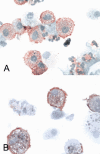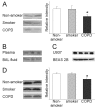Glutathione S-transferase omega in the lung and sputum supernatants of COPD patients
- PMID: 17617905
- PMCID: PMC1939846
- DOI: 10.1186/1465-9921-8-48
Glutathione S-transferase omega in the lung and sputum supernatants of COPD patients
Abstract
Background: The major contribution to oxidant related lung damage in COPD is from the oxidant/antioxidant imbalance and possibly impaired antioxidant defence. Glutathione (GSH) is one of the most important antioxidants in human lung and lung secretions, but the mechanisms participating in its homeostasis are partly unclear. Glutathione-S-transferase omega (GSTO) is a recently characterized cysteine containing enzyme with the capability to bind and release GSH in vitro. GSTO has not been investigated in human lung or lung diseases.
Methods: GSTO1-1 was investigated by immunohistochemistry and Western blot analysis in 72 lung tissue specimens and 40 sputum specimens from non-smokers, smokers and COPD, in bronchoalveolar lavage fluid and in plasma from healthy non-smokers and smokers. It was also examined in human monocytes and bronchial epithelial cells and their culture mediums in vitro.
Results: GSTO1-1 was mainly expressed in alveolar macrophages, but it was also found in airway and alveolar epithelium and in extracellular fluids including sputum supernatants, bronchoalveolar lavage fluid, plasma and cell culture mediums. The levels of GSTO1-1 were significantly lower in the sputum supernatants (p = 0.023) and lung homogenates (p = 0.003) of COPD patients than in non-smokers.
Conclusion: GSTO1-1 is abundant in the alveolar macrophages, but it is also present in extracellular fluids and in airway secretions, the levels being decreased in COPD. The clinical significance of GSTO1-1 and its role in regulating GSH homeostasis in airway secretions, however, needs further investigations.
Figures






References
Publication types
MeSH terms
Substances
LinkOut - more resources
Full Text Sources
Other Literature Sources
Medical
Miscellaneous

